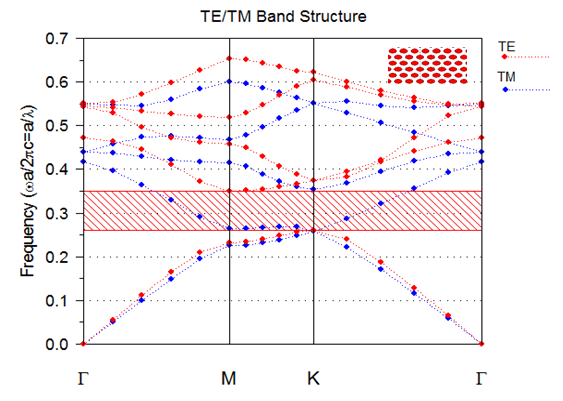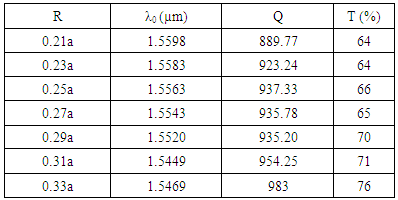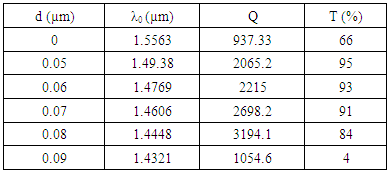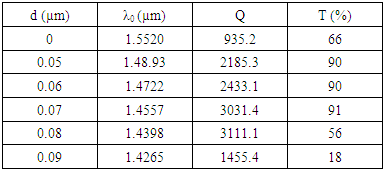-
Paper Information
- Next Paper
- Previous Paper
- Paper Submission
-
Journal Information
- About This Journal
- Editorial Board
- Current Issue
- Archive
- Author Guidelines
- Contact Us
Nanoscience and Nanotechnology
p-ISSN: 2163-257X e-ISSN: 2163-2588
2016; 6(1A): 29-34
doi:10.5923/c.nn.201601.05

Design of Photonic Crystal Demultiplexer for Optical Communication Application
Ahlem Benmerkhi , Mohamed Bouchemat , Touraya Bouchemat
Département d’électronique, Faculté des sciences de technologie, Université des frères mentouri Constantine, Algeria
Correspondence to: Ahlem Benmerkhi , Département d’électronique, Faculté des sciences de technologie, Université des frères mentouri Constantine, Algeria.
| Email: |  |
Copyright © 2016 Scientific & Academic Publishing. All Rights Reserved.
This work is licensed under the Creative Commons Attribution International License (CC BY).
http://creativecommons.org/licenses/by/4.0/

A greatly efficient design of a two-channel wavelength demultiplexer in the telecommunication region is presented with finite-difference time domain simulations. The proposed channel demultiplixer is made of two waveguide couplers and one microcavity. The transmission spectra and the field patterns are obtained by using Fullwave which is a commercially available finite-difference- time-domain (FDTD) code. We design and simulate the desired cavities based on photonic crystal to separate two wavelengths with 5.3 nm channel spacing, 13.8 dB crosstalk, and acceptable quality factor.
Keywords: Microcavity, Photonic Crystal, Waveguide and Demultiplixer
Cite this paper: Ahlem Benmerkhi , Mohamed Bouchemat , Touraya Bouchemat , Design of Photonic Crystal Demultiplexer for Optical Communication Application, Nanoscience and Nanotechnology, Vol. 6 No. 1A, 2016, pp. 29-34. doi: 10.5923/c.nn.201601.05.
Article Outline
1. Introduction
- A photonic crystal (PC) with photonic band gap is a promising candidate as a platform on which to construct devices with dimensions of several wavelengths for future photonic integrated circuits. PCs are particularly interesting, in all-optical systems to transmission and processing information due to the effect of localization of the light in the defect region of the periodic structure. There are many possible device applications of compact and efficient PCS nanocavities, such as channel drop filters [1], low-threshold lasers [2], cavity QED experiments [3], optical switching [4, 5] and optical sensing [6].Moreover, several example applications for telecommunication such as wavelength division multiplexing and wavelength division demultiplexing (WDDM) have been proposed [7-9]. In realizing the photonic crystal based WDDM, different wavelength selective filtering techniques have been used. Waveguide based filters which utilize coupling between two closely spaced waveguides [10, 11], filters that couple two waveguides using a cavity [7-10], and negative refractive index super-prism based filters [12] are some of the examples which have recently been used to achieve PC based wavelength demultiplexing. In these researches all tries have been led to obtain demultiplexers that able to select different wavelengths with ultra narrow band width, high resolution and optimum efficiency. On the other hand, high quality factor (Q), low channel spacing and high efficiency are the specific and desired characteristics. Our research is aimed at studying the demultiplexing capabilities of photonic crystals in the telecommunication region. We propose a new design with 2D PCs for two-channel demultiplexer that is capable to support more channels. In this structure, we obtained demultiplexer with two channels with 5.3 nm channel spacing and 13.8 dB crosstalk. The quantity of Q is 3346.6 for first wavelength and 2540.2 for the other one. Photonic crystal cavities have special properties. One of the important characteristics of them is their ability to confine light and trap particular wavelengths strongly. This main property cause researchers apply them in their proposed structures for demultiplexers. There are some applications in engineering tasks, such as ultra-small filters [13], low-threshold lasers [14], photonic integrated circuits [15], nonlinear optic switches [16] in which photonic crystal cavities can be used.
2. The Photonic Crystal Design
- To take advantages of well-developed CMOS technology for making nanometer-scale photonic devices, silicon-on- insulator (SOI) is chosen as the structure material. Due to the high RI contrast of structure materials and PC properties, the optical confinements inside the PC waveguides and cavities are very strong, benefiting a small device footprint and low radiation loss at sharp bends. The host structure of PC is based on 2D hexagonal lattices, consisting of air holes with a lattice constant “a” and air hole radius r is 0.33a.The whole structure is fabricated on a SOI layer with a height (h) of 252 nm. With the index profile of silicon slab (nSi = 3.4), air upper and lower claddings (nair = 1), the regular PC has the first photonic bandgap for TE mode in normalized frequency range between 0.26 (aω/2πc) and 0.3488 (aω/2πc), equivalent to the wavelength range of 1.20 – 1.61 µm. This result was confirmed by simulation based on FDTD algorithm (RSoft Photonic Suite), as shown in Fig. 1.
3. Design Process and Simulation
- The computational method used is based on a 2D finite difference time domain (FDTD) method algorithm. Perfectly matched layers (PML) conditions have been considered in the calculations to ensure no back reflection in the limit of the analyzed region [17]. This crystal is light by a Gaussian wave under normal incidence with a transverse electric (TE) polarized. Here the calculation field consists of a 26 x 26 matrix of air pores and the time step is chosen to 0.016. Note that it might be necessary to reduce the time step below the stability limit when simulating metals since the courant condition can change in this case.The time step for 2D structure is determined by:
 Where C is the speed of light in free space.
Where C is the speed of light in free space.3.1. High Q Microcavity
- We investigate the coupling of linear three-hole cavities (L3) [18] into PC waveguides. We choose the L3 cavities for their high quality factor (Q) to mode volume (V) ratio and good matching between cavity and waveguide field patterns, which improves in-plane coupling efficiency [19-21]. The ‘L3’ defect was the first type of photonic crystal (PC) cavity in which quality (Q) factors in excess of 104 were obtained experimentally [18]. This cavity consists of a PC with a line of three holes missed out of a hexagonal lattice. The cavity mode, whose magnetic field configuration is depicted in figure 2(a), needs to be coupled to one of the guided modes in the PC waveguide. The field is computed using two dimensional finite difference time domain simulations (2D FDTD). Of the possible waveguide bands inside the PC band gap [22] the best choice for coupling the L3 cavity is the one with similar symmetry and frequency as the L3 cavity mode (figure 2(b)).
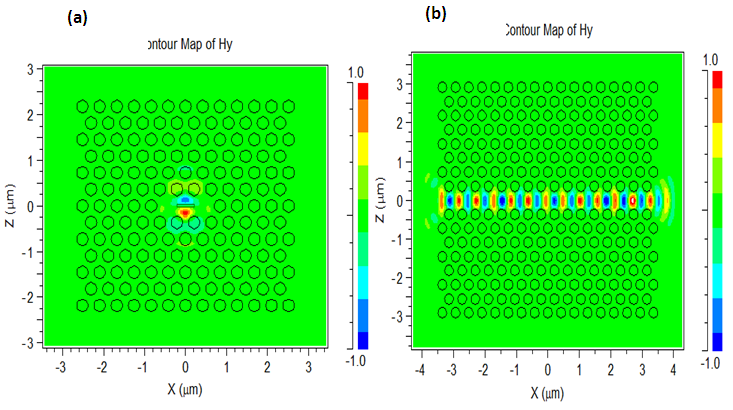 | Figure 2. (a) Magnetic field for the mode with the highest quality factor in a L3 cavity, (b) Magnetic field of the PC waveguide |
3.2. Single Wavelength output Coupling Structure
- We consider a structure with a single resonance cavity that is shown in Fig 3. It is made in a triangular lattice of air holes in silicon which has been chosen because triangular lattices may exhibit large bandgaps and because silicon is expected to be a good platform for photonic integrated circuits and ultracompact optical devices.
 | Figure 3. A structure with a single resonance cavity, one input waveguide and one output waveguide |
 | Figure 5. Simulated magnetic field of a cavity–waveguide coupler in with four-hole separtion |
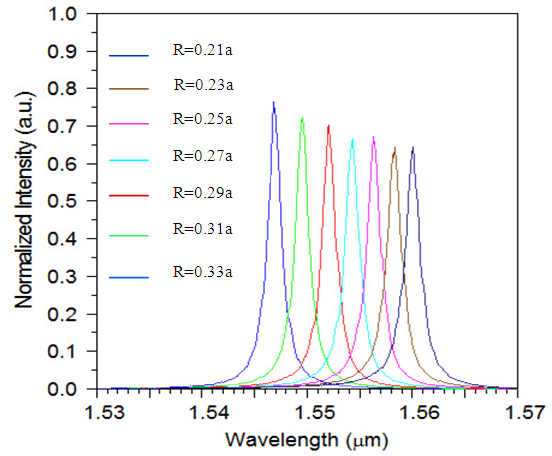 | Figure 6. The output of the filter for d = 0, N=4, and different values of R |
|
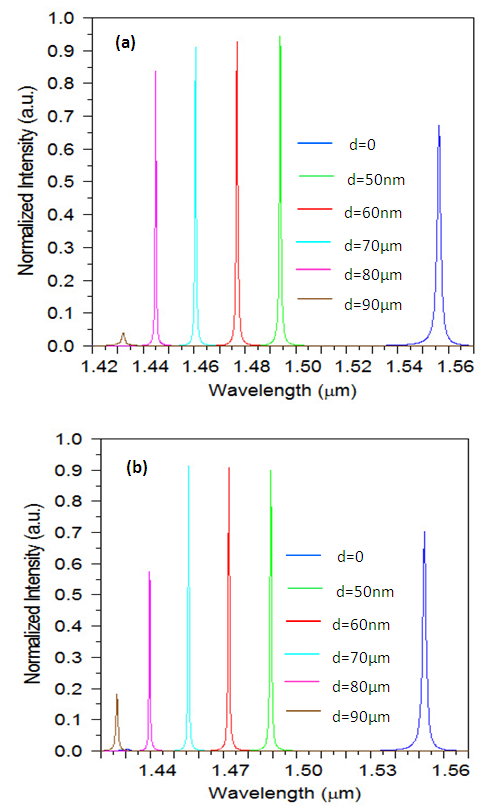 | Figure 7. The output of the filter for different values of "d", (b) for R = 0.25a, and (b) for R = 0.29a |
|
|
3.3. The WDDM Structure
- The final design structure was produced by bringing all the results from the previous steps together. By combining two different single channel output couplers, each with their own high Q-factor resonators, a two-channel wavelength demultiplexer can be created (Fig. 8). We used two cavities with difference defect radius (indicated by the blue circles) and by shifting down and up the upper and lower middle pores respectively by d=70nm (indicated by the green circles) in two suitable places to select two different wavelengths.
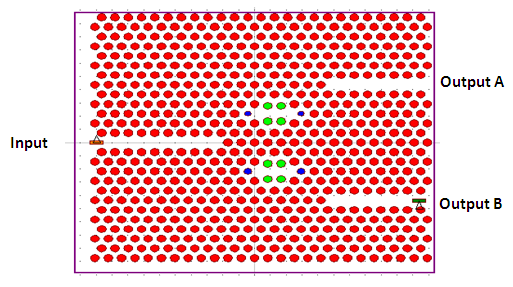 | Figure 8. Final proposed structure for two wavelengths division demultiplexing |
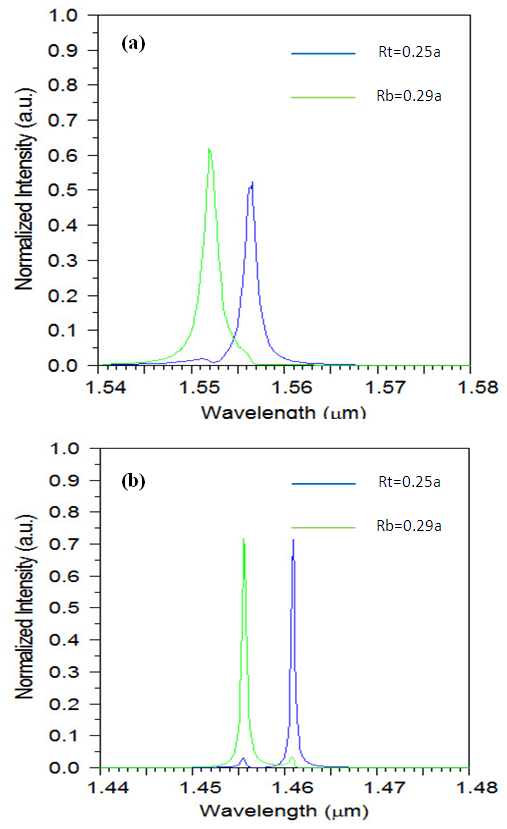 | Figure 9. Final structure output with align radiuses of defects equal to Rt=0.25a and Rb=0.29a: (a) d=0 and (b) d=70nm |
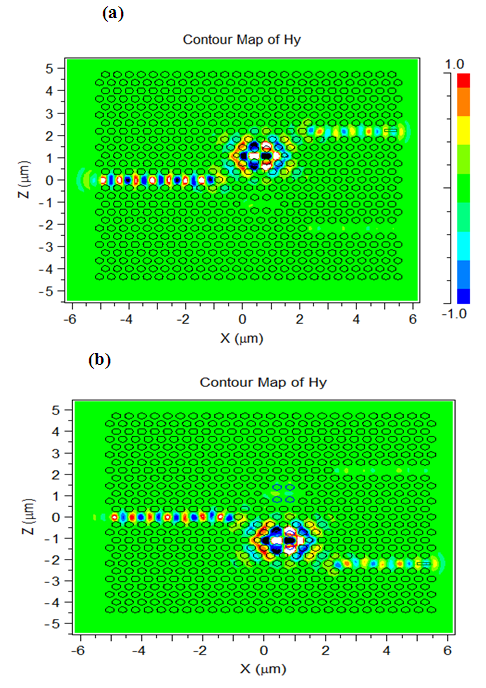 | Figure 10. Simulated magnetic field of a demultiplixer with four hole separation (N=4) (a) at 1.4606 µm for R=0.25a, d=70nm and (b) at 1.4556µm for R=0.29a and d=70nm |
4. Conclusions
- In this work, we have designed a high efficiency wavelength demultiplexer for two different wavelengths, 1.4609µm and 1.4556µm, using a triangular photonic lattice in a planar waveguide structure. We have shown theoretically that the coupling between a L3 PC cavity and PC waveguides can be improved by shifting down and up the upper and lower middle pores respectively. According to the resonance cavity characteristics which can be demultiplexe different wavelengths by changing "d" and by regulating the radius of defects "R" in cavity, this structure can separates two wavelengths with 5.3 nm channel spacing. The other properties of the proposed structure are low crosstalk and tolerable efficiency.
 Abstract
Abstract Reference
Reference Full-Text PDF
Full-Text PDF Full-text HTML
Full-text HTML